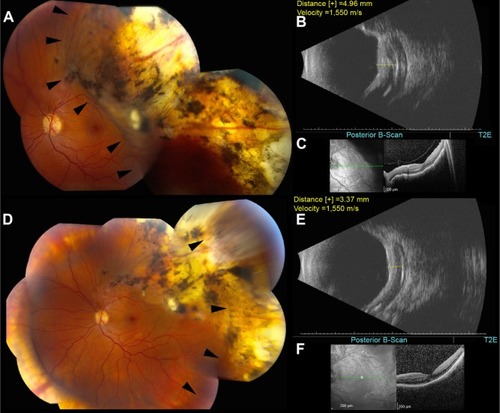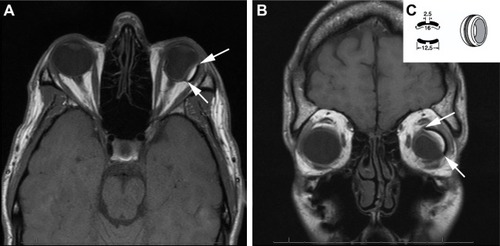Abstract
We present a case of a 41-year-old man who was referred for evaluation of a choroidal tumor with a remote history of scleral buckle placement for traumatic retinal detachment. Ocular imaging, echography, and magnetic resonance imaging could not rule out a neoplastic process so the patient was taken for surgical exploration where a hemorrhagic cyst was discovered. This is the first case in the literature of a silicone scleral buckle–associated hemorrhagic cyst presenting as orbital mass.
Introduction
Scleral buckle (SB) placement is a common procedure for the management of rhegmatogenous retinal detachments. Complications from SB surgery include exposure or migration, infection, strabismus, and foreign body sensation.Citation1 There have been cases of expansile hydrogel SBs simulating orbital massesCitation2,Citation3 but here we report the first case of a silicone SB with a periocular hemorrhagic cyst masquerading as an orbital tumor.
Case report
A 41-year-old man was referred for evaluation of a choroidal tumor. He had decreased vision and a new nasal visual field defect OS. There was no recent trauma or eye surgery; however, at 10 years of age he underwent SB procedure for a traumatic retinal detachment in his OS. Operative reports indicated that a segmental concave 281-type silicone tire was placed superotemporally. He was being treated with aspirin, lisinopril, and metoprolol for chronic heart failure. There was no history of cancer.
His vision measured 20/20 OD and 20/150 OS and his intraocular pressure was 18 mmHg OU. A dilated fundus exam OS suggested that there was an elevated choroidal mass in the superotemporal mid-periphery with overlying chorioretinal scarring and a buckle with moderate height (). Echography detected an extrascleral lesion outside the choroid between the SB and the globe centered at 2 o’clock with a maximum apical thickness of 4.96 mm (). Optical coherence tomography (OCT) displayed distortion of the outer retina and choroid with intact retinal pigment epithelium ().
Figure 1 Color fundus, B-scan echography, and OCT images of the left eye.
Abbreviation: OCT, optical coherence tomography.

Magnetic resonance imaging (MRI) of the orbits and brain revealed a relatively homogeneous crescent mass between the globe and SB (). Consistent with a 281-style concave silicone tire, the anterior–posterior chord length of the SB element measured 12.5 mm (), and extended circumferentially around the globe from 11.30 to clockwise 4 o’clock (). No other scans other than the native T1 sequences were done and this is a limitation of the study. Consequently, because of his concern for an orbital neoplastic process, the patient underwent orbital exploration; pathology revealed a hemorrhagic cyst within the silicone SB capsule and no neoplastic tissue. The patient began oral prednisone 60 mg daily with a taper over 3 weeks, as an anti-inflammatory agent to minimize tissue edema of the hemorrhagic cyst.
Figure 2 MRI of the orbits and brain.
Abbreviation: MRI, magnetic resonance imaging.

Over the next 3 months, the patient’s visual field defect resolved. The choroidal indentation became progressively smaller () and the visual acuity improved to his baseline of 20/40. Echography showed a decreased maximum apical height of 3.37 mm (). The temporal macula flattened with minimal distortion of the choroid on OCT (). A recurrent episode resolved without surgery using only oral prednisone.
Discussion
Orbital foreign body simulating an ocular tumor is uncommon, occurring in less than 1% of cases presenting with an intraorbital mass.Citation4 Even less common is SB presenting as an orbital lesion with enlargement of the SB elements. To date, these reports have involved the use of hydrogel implants (MIRAgel; Waltham, MA, USA), which were popular in the 1980s and early 1990s before being discontinued. These hydrogel implants were marketed as soft, flexible implants with physical properties allowing them to swell over time. The implant was discontinued due to complications, and it is currently recommended that MIRAgel buckling elements be promptly removed at the onset of discomfort to avoid late complications.Citation5
We present the first case of a silicone SB-associated hemorrhagic cyst presenting as an orbital mass. Silicone is inert and unable to enlarge like hydrogel implants; consequently, the possibility of this type of SB presenting as an orbital mass has not been previously reported. Clinicians should be aware of this entity in patients with a previous silicone SB. Standardized echography and MRI imaging can localize the mass between the SB and sclera, for which the changes in choroidal elevation are secondary to the mass effect from the hemorrhagic cyst.
Ethics statement
Full adherence to the Declaration of Helsinki and all Federal and State laws was observed.
Author contributions
Dr Almeida and Dr Mahajan had full access to all the data in the study and take full responsibility for the integrity of the data and the accuracy of the data analysis. All authors contributed to the design and conduct of the study; collection, management, analysis, and interpretation of the data; preparation, review, and approval of the manuscript; and the decision to submit the manuscript for publication.
Disclosure
The authors report no conflicts of interest in this work.
References
- CovertDJWirostkoWJHanDPRisk factors for scleral buckle removal: a matched, case-control studyAm J Ophthalmol2008146343443918614132
- Roldán-PallarésMdel Castillo SanzJLAwad-El SusiSRefojoMFLong-term complications of silicone and hydrogel explants in retinal reattachment surgeryArch Ophthalmol1999117219720110037564
- ShieldsCLDemirciHMarrBPMashayekhiAMaterinMAShieldsJAExpanding MIRAgel scleral buckle simulating an orbital tumor in four casesOphthal Plast Reconstr Surg20052113238
- ShieldsJAShieldsCLScartozziRSurvey of 1,264 patients with orbital tumors and simulating lesions: The 2002 Montgomery Lecture, part 1Ophthalmology20041115997100815121380
- Roldán-PallarésMHernández-MonteroJLlanesFFernández-RubioJEOrtegaFMIRAgel: hydrolytic degradation and long-term observationsArch Ophthalmol2007125451151417420371
